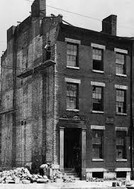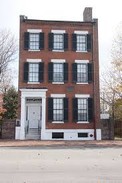Field House Museum
Introduction
Text-to-speech Audio
This museum is located in the birthplace and early childhood residence of Eugene Field *1850-1895), a popular author of children’s literature in the 19th century. Field's poems for children led to his rise in the literary world, and when he passed away at age 45, he was known as "the Children's Poet." In 1902, Mark Twain unveiled a plaque honoring Field that recognized this rowhouse as Field's birthplace. The remaining rowhomes
was so well-known that In recent years, there has been greater emphasis on the life of Eugene's son Roswell Field, the attorney who formulated the legal strategy for Dred Scott's lawsuit for freedom before the Supreme Court. The house is a museum with a vast collection of historic toys, and it also serves as a place where visitors can learn about the Dred Scot case. The museum includes artifacts and items related to the era in which Roswell, Frances, and Eugene Field lived within its walls. The house features special exhibits, workshops, and conferences on civil rights, law and social justice. The museum was also offers displays related to Eugene Field's career and historic toys. Eugene Field came to be known as the “Children’s Poet” for his stories and poems, which include “Little Boy Blue” and “Wynken, Blynken and Nod.” The house was saved from demolition in 1934 due to its significance as the early boyhood home of Eugene Field, the “Children’s Poet” and Roswell Field’s son.
Images
The Eugene Field - home of Roswell Field and his son Eugene Field.

Front view of the The Eugene Field House.

Backstory and Context
Text-to-speech Audio
In recent years, the museum's programs and exhibits have focused on Roswell Field, son of the children's author and an attorney who brought into federal court the freedom suit of Dred Scott. The trial took place in 1847 and brought national attention to the issue of slavery and the growing division between states that continued to practice slavery. While the Scott family had several attorneys during their battle for freedom, without Roswell Field’s creative legal strategy, the Supreme Court would have likely not been compelled to hear the case. While Scott and his attorneys emphasized that he had lived in states where slavery was illegal and should, therefore, be freed from bondage, the Court declared that no enslaved person could be a U.S. citizen or seek legal protection provided to citizens through the nation's courts. The decision anger abolitionists as well as those who defended the rights of Northern states to prevent slaveholders from bringing enslaved people into their state as property in violation of their laws. The decision also widened the political gap between those who hoped to extend slavery into the West and those who sought to contain it to the Southern states.
Roswell Field's father, Eugene Field, was an American writer best known for his children's poetry and humorous essays. At the time this home became a museum, Eugene Field was the focus of exhibits and the museum collection centered on literature, toys, and other items related to childhood. Field's career spanned multiple genres, but he was best known as the author of many poems and short stories for children. His most famous poems are “Winken, Blinken, and Nod” and "The Duel", to name but a few. Field first started publishing poetry in 1879, when his poem "Christmas Treasures" appeared in A Little Book of Western Verse. He died in Chicago of a heart attack at the age of 45.
The land on which Field House was built was once owned by Pierre Laclede, a man widely recognized as a leading founder of St. Louis. After he died, Laclede’s estate sold the property to Auguste Chouteau, Laclede’s associate. Following Chouteau’s death in 1820, the land was conveyed to the City of St. Louis with the provision that revenue from its use be spent for public schools. The Field House was one in a series of roadhouses within a fashionable residential neighborhood known as Walsh’s Row. Developed in the 1840s by Edward Walsh, it comprised twelve identical three-story row houses, including this last-surviving remnant of Walsh’s Row.
In 1934, when Walsh's row was about to be torn down, Irving Dilliard wrote a spirited editorial in the St. Louis Post-Dispatch decrying the destruction of Eugene Field's birthplace. Insurance agents Jesse P. Henry and Carl formed a committee to save the house, and the Board of Education took possession, preserving that single unit of Walsh's Row. Under Henry’s leadership, the building was restored and opened as a museum in December of 1936. The Board of Education maintained the house until 1968 when it transferred that function to the Landmarks Association of St. Louis, Inc., who oversaw the house until 1981 when the Eugene Field House Foundation took over. In March of 2007 the Eugene Field House was designated as a National Historic Landmark by Interior Secretary Dirk Kempthorne.
Sources
Coyle, Elinor Maartineau. Old St. Louis Homes (1790-1865): The Stories They Tell. St. Louis: Folkstone,1964.
A St. Louis Heritage: Six Historic Homes. Southwestern Bell Telephone, 1967.
http://www.nps.gov/nhl/find/statelists/mo/FieldHouse.pdf http://www.eugenefieldhouse.org/
http://explorestlouis.com/media-page/news-releases-newsroom/releases/many-st-louis-sites-significant-in-Black-history/ http://www.cpdit01.com/resources/planning-and-development.fountains-monuments-and-sculptures/Lincoln%20Park%20Zoo/Eugene%20Field%20Memorial.pdf
http://eugenefieldhouse.org/resources/Page-Artwork/Campaign-Brochure.pdf
